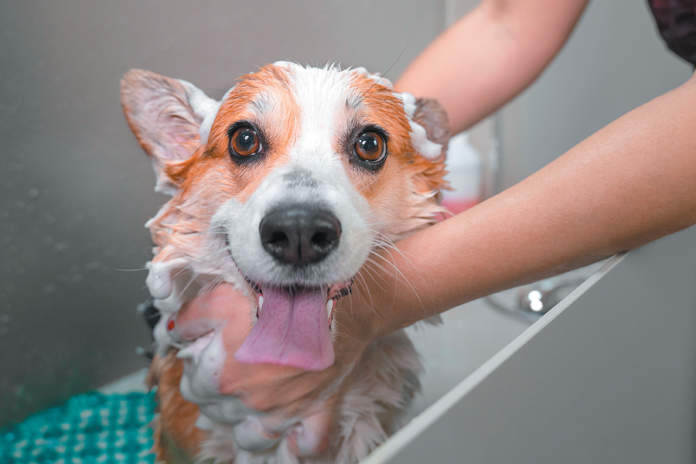People spend hundreds of millions of dollars on dog shampoo each year, with the amount increasing annually. And there are a lot of shampoos to choose from, with ingredients ranging from aloe, coconut oil, lavender oil, and honey to various herbs and vitamins. Do you know which ingredients to look for? Or how often you should bathe your dog, or how hot to keep the water? Answer these questions to find out.
1.Water used to bathe a dog should be
A) Cool.
B) On the hot side but not scalding.
C) Somewhere between warm and hot.
D) Somewhere between warmand tepid.
D. While many people prefer a hot bath or shower, dogs like the water rather tepid. If the water feels right to you, in fact, it’s probably too hot for your pet. When you test it before spraying it on your dog, it should feel lukewarm — pretty much like room temperature.
2. True or false? While there are many dog shampoos for sale, they are not essential for your pet. Any baby shampoo will be gentle enough for the canine body.
False. Our skin is much more acidic than that of our dogs and can stand up to the ingredients in shampoos made for people. But those shampoos we use on ourselves can wash away a dog’s own mantle — a lightly acidic layer of skin that serves as a barrier to environmental contaminants like bacteria and viruses. In fact, using a people shampoo on a dog might actually increase unpleasant pet scents because it can pave the way for the colonization of bacteria that create bad smells. A shampoo formulated for people will also leave a dog’s skin dry and perhaps irritated. Dogs have thinner skin than we do and thus cannot as easily withstand “assaults” from chemicals that shouldn’t be massaged in.
3. You should look for a dog shampoo that contains which of the following ingredients? (There may be more than one right answer.)
A) Vitamin A
B) Vitamin E
C) Taurate
D) Mineral oil
E) Sodium laureth sulfate
F) Coconut oil
C or E. Taurate and laureth sulfate are the two substances that will do the best job of cleansing your dog without harming his delicate skin. It’s okay if you don’t see both ingredients listed, but you should see at least one of them.
If you want to condition your dog’s coat in addition to washing it, look for any of these three ingredients: behentrimonium, glycerin, or cetearyl alcohol.
4. A dog needs to be bathed
A) Once a month.
B) Once a week.
C) Once every 2 months.
D) Once every 2 weeks.
E) Once every 6 weeks.
F) Pretty much when you think.
F. For healthy dogs, the frequency of bathing can be determined largely by the pet’s coat and odor. Some dogs can go long periods without bathing so long as the coat is groomed and maintained mat-free, says Tufts veterinary dermatologist Ramón Almela, DVM.
Many dogs prefer to be bathed rather infrequently. Dogs accumulate scents in their day-to-day excursions that alert other dogs to where they have been and what they have seen. Odors on a dog are a powerful form of communication between canines.
Bottom line: How often you bathe your pet is your call depending on how dirty or odorous your dog becomes, although veterinary dermatologists generally recommend not more than once every two weeks. For most dogs, every month or two should suffice.
Itchy skin. A dog with itchy skin will benefit from moisturizers and other ingredients. These ingredients will soothe the itch by helping to prevent the skin from drying out and also restoring the skin barrier.
Medicated or special care shampoos are often recommended for the one in 10 dogs whose skin itches from atopic dermatitis, which is essentially an allergy to an airborne allergen like pollen, dust, mites, or mold and causes everything from scratching to biting, licking, and rubbing. While some dogs hate having a bath, dogs with atopic dermatitis are generally thankful for their baths because they help relieve the itching.
Because there are several possible reasons for itchy skin, your veterinarian should recommend a shampoo after diagnosing your pet’s skin problems and needs. In such cases, bathing once to twice a week may be recommended.
Bacterial and yeast infections. Your veterinarian will prescribe appropriate treatment that may include a medicated shampoo if a skin infection has been diagnosed.






Sodium Laureth Sulfate has been linked to cancer in humans so I would not use it on a dog!
I doubt very much that putting it on your dog a couple of times a month for 15 minutes and then rinsing it would be harmful. I also doubt that there veterinarian experts would recommend using it if it was potentially harmful. I am not aware of any legitimate scientific research that has concluded that using a normal amount of this substance for bathing causes cancer.
As a result of my research I do not use any products that contain Sodium laureth sulfate because of its links to health issues. I would therefore not use any product with it on any of my animals.
What about Dawn Dish detergent? Kills fleas & used to clean wildlife after oil spills?
Dawn detergent is great at removing grease and oils so it is used on animals after exposure to oil spills. But for normal bathing it is too harsh because it is so good at removing oils. A dog’s skin has natural oils that help keep the skin and hair healthy. Stripping them with a product like Dawn is not a good idea.
I am very curious regarding the response from Beverley Hollander. Cancer?
I am curious about shampoos containing oatmeal. So many of the ones marketed for dry, itchy or sensitive skin contain oatmeal. But it seems like oatmeal would be drying.
Depending on manufacturing processes, sodium laureth sulfate may be contaminated with measurable amounts of ethylene oxide and 1,4-dioxane. i The International Agency for Research on Cancer ethylene oxide as a known human carcinogen and 1,4-dioxane as a possible human carcinogen. Ethylene oxide can also harm the nervous system iiand the California Environmental Protection Agency has classified it as a possible developmental toxicant based on evidence that it may interfere with human development. iii 1,4-dioxane is also persistent. In other words, it doesn’t easily degrade and can remain in the environment long after it is rinsed down the shower drain. 1,4-dioxane can be removed from cosmetics during the manufacturing process by vacuum stripping, but there is no easy way for consumers to know whether products containing sodium laureth sulfate have undergone this process.
Not good for humans..not good for animals.
It travels into your system via the skin, and as noted in the article, dogs skin is thinner than humans. Plenty of safer options available. Earthbath is one brand.